Radiography Report: Factors Influencing Decision Making
VerifiedAdded on 2022/12/27
|7
|1547
|21
Report
AI Summary
This report examines inequalities in healthcare, focusing on the factors that influence decision-making in patient prioritization within a radiography context. The report begins by highlighting the importance of equitable healthcare and the various factors that contribute to disparities, such as income, education, and discrimination. It analyzes a scenario where inequalities were evident, particularly in the prioritization of patients based on socioeconomic status and awareness of healthcare policies. The main body discusses the impact of these inequalities and the importance of achieving health equity. It then explores the decision-making process in healthcare, including steps such as gathering information and reviewing decisions, and identifies several factors influencing patient prioritization, including patient non-compliance with lifestyle changes, risk assessment, clinical indications, symptom severity, and patient medical stability. The report concludes by reiterating the impact of these factors on healthcare delivery, emphasizing the need to address inequalities and promote effective treatment for all patients. The report references several academic sources to support its findings.

Radiography
1
1
Paraphrase This Document
Need a fresh take? Get an instant paraphrase of this document with our AI Paraphraser
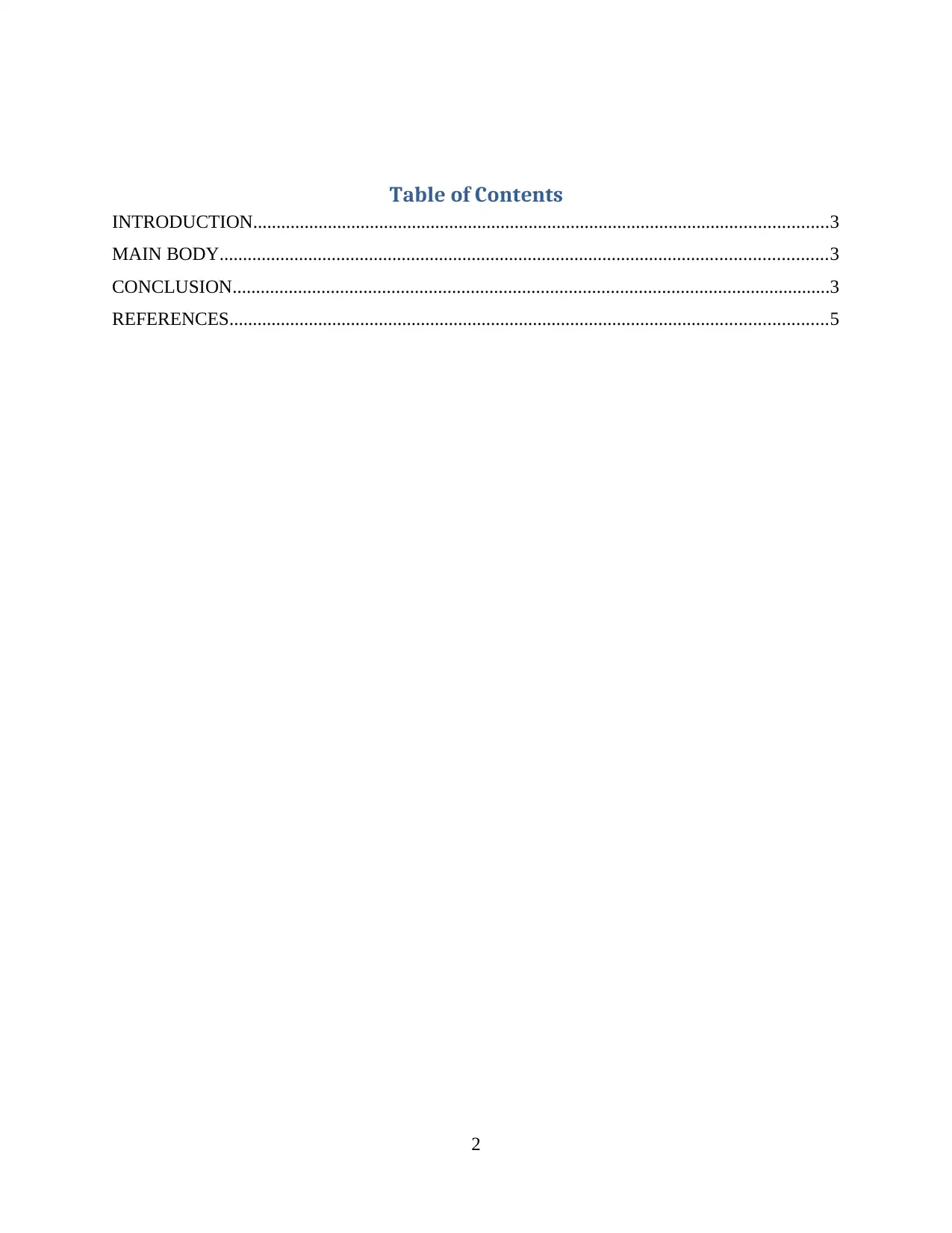
Table of Contents
INTRODUCTION...........................................................................................................................3
MAIN BODY..................................................................................................................................3
CONCLUSION................................................................................................................................3
REFERENCES................................................................................................................................5
2
INTRODUCTION...........................................................................................................................3
MAIN BODY..................................................................................................................................3
CONCLUSION................................................................................................................................3
REFERENCES................................................................................................................................5
2
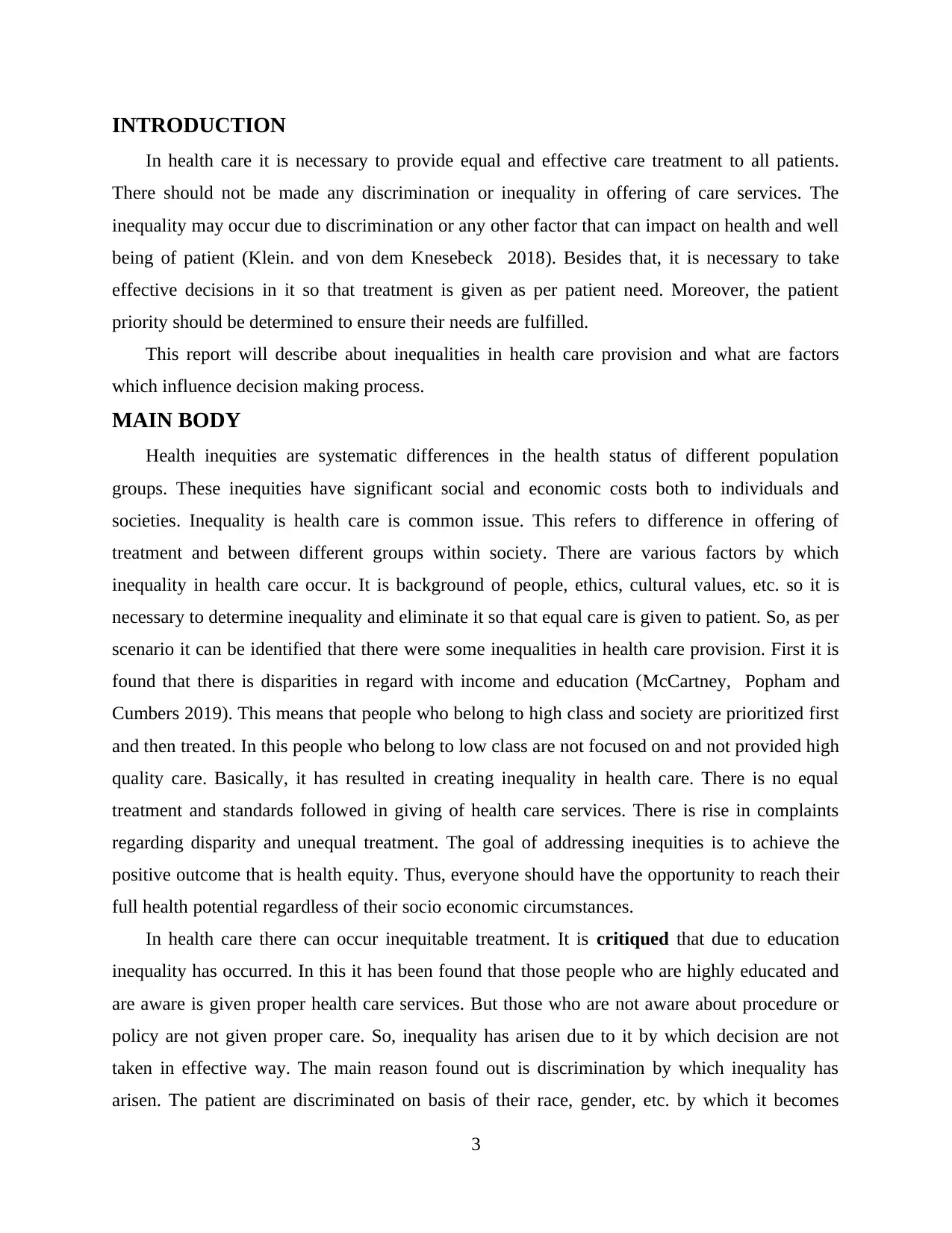
INTRODUCTION
In health care it is necessary to provide equal and effective care treatment to all patients.
There should not be made any discrimination or inequality in offering of care services. The
inequality may occur due to discrimination or any other factor that can impact on health and well
being of patient (Klein. and von dem Knesebeck 2018). Besides that, it is necessary to take
effective decisions in it so that treatment is given as per patient need. Moreover, the patient
priority should be determined to ensure their needs are fulfilled.
This report will describe about inequalities in health care provision and what are factors
which influence decision making process.
MAIN BODY
Health inequities are systematic differences in the health status of different population
groups. These inequities have significant social and economic costs both to individuals and
societies. Inequality is health care is common issue. This refers to difference in offering of
treatment and between different groups within society. There are various factors by which
inequality in health care occur. It is background of people, ethics, cultural values, etc. so it is
necessary to determine inequality and eliminate it so that equal care is given to patient. So, as per
scenario it can be identified that there were some inequalities in health care provision. First it is
found that there is disparities in regard with income and education (McCartney, Popham and
Cumbers 2019). This means that people who belong to high class and society are prioritized first
and then treated. In this people who belong to low class are not focused on and not provided high
quality care. Basically, it has resulted in creating inequality in health care. There is no equal
treatment and standards followed in giving of health care services. There is rise in complaints
regarding disparity and unequal treatment. The goal of addressing inequities is to achieve the
positive outcome that is health equity. Thus, everyone should have the opportunity to reach their
full health potential regardless of their socio economic circumstances.
In health care there can occur inequitable treatment. It is critiqued that due to education
inequality has occurred. In this it has been found that those people who are highly educated and
are aware is given proper health care services. But those who are not aware about procedure or
policy are not given proper care. So, inequality has arisen due to it by which decision are not
taken in effective way. The main reason found out is discrimination by which inequality has
arisen. The patient are discriminated on basis of their race, gender, etc. by which it becomes
3
In health care it is necessary to provide equal and effective care treatment to all patients.
There should not be made any discrimination or inequality in offering of care services. The
inequality may occur due to discrimination or any other factor that can impact on health and well
being of patient (Klein. and von dem Knesebeck 2018). Besides that, it is necessary to take
effective decisions in it so that treatment is given as per patient need. Moreover, the patient
priority should be determined to ensure their needs are fulfilled.
This report will describe about inequalities in health care provision and what are factors
which influence decision making process.
MAIN BODY
Health inequities are systematic differences in the health status of different population
groups. These inequities have significant social and economic costs both to individuals and
societies. Inequality is health care is common issue. This refers to difference in offering of
treatment and between different groups within society. There are various factors by which
inequality in health care occur. It is background of people, ethics, cultural values, etc. so it is
necessary to determine inequality and eliminate it so that equal care is given to patient. So, as per
scenario it can be identified that there were some inequalities in health care provision. First it is
found that there is disparities in regard with income and education (McCartney, Popham and
Cumbers 2019). This means that people who belong to high class and society are prioritized first
and then treated. In this people who belong to low class are not focused on and not provided high
quality care. Basically, it has resulted in creating inequality in health care. There is no equal
treatment and standards followed in giving of health care services. There is rise in complaints
regarding disparity and unequal treatment. The goal of addressing inequities is to achieve the
positive outcome that is health equity. Thus, everyone should have the opportunity to reach their
full health potential regardless of their socio economic circumstances.
In health care there can occur inequitable treatment. It is critiqued that due to education
inequality has occurred. In this it has been found that those people who are highly educated and
are aware is given proper health care services. But those who are not aware about procedure or
policy are not given proper care. So, inequality has arisen due to it by which decision are not
taken in effective way. The main reason found out is discrimination by which inequality has
arisen. The patient are discriminated on basis of their race, gender, etc. by which it becomes
3
⊘ This is a preview!⊘
Do you want full access?
Subscribe today to unlock all pages.

Trusted by 1+ million students worldwide
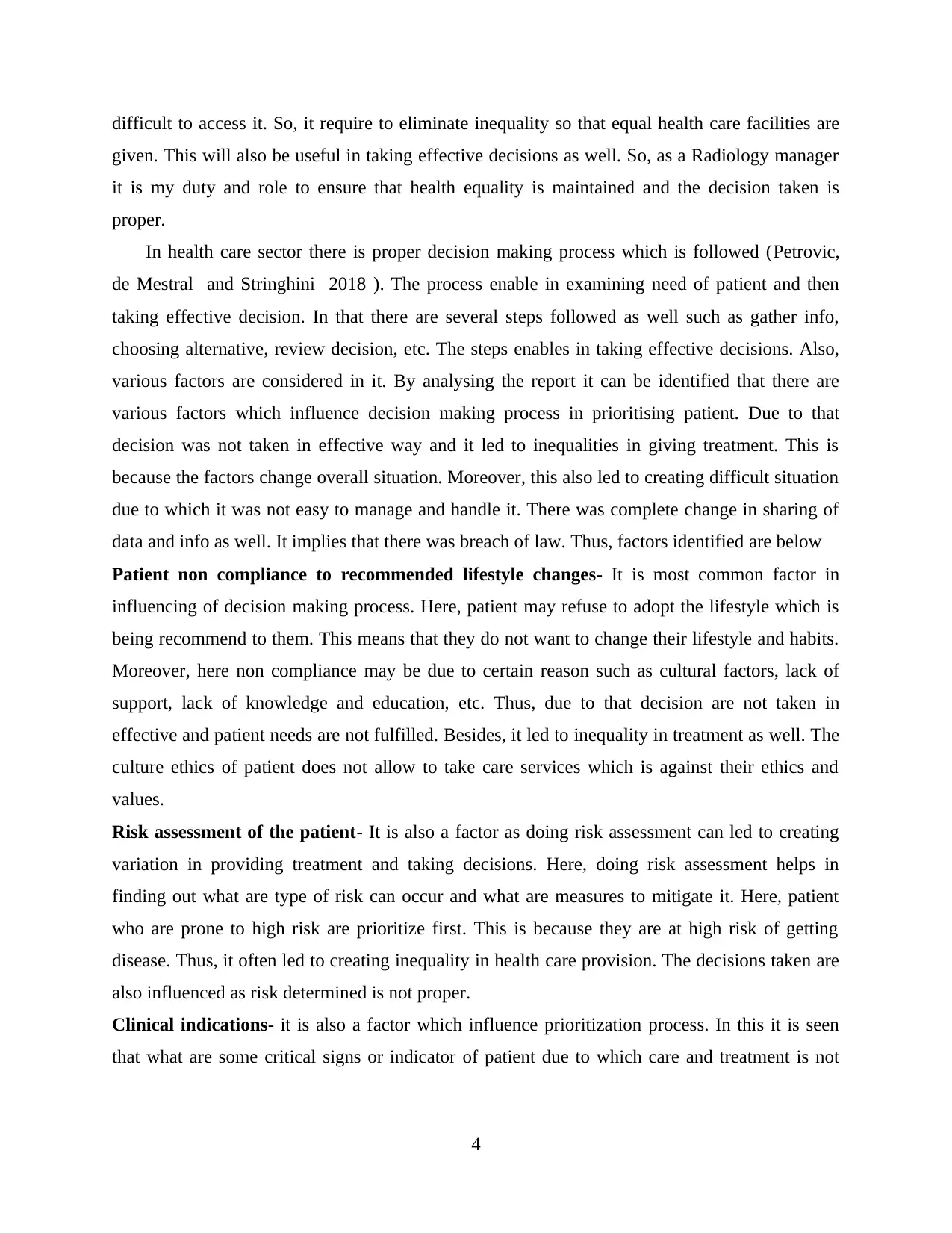
difficult to access it. So, it require to eliminate inequality so that equal health care facilities are
given. This will also be useful in taking effective decisions as well. So, as a Radiology manager
it is my duty and role to ensure that health equality is maintained and the decision taken is
proper.
In health care sector there is proper decision making process which is followed (Petrovic,
de Mestral and Stringhini 2018 ). The process enable in examining need of patient and then
taking effective decision. In that there are several steps followed as well such as gather info,
choosing alternative, review decision, etc. The steps enables in taking effective decisions. Also,
various factors are considered in it. By analysing the report it can be identified that there are
various factors which influence decision making process in prioritising patient. Due to that
decision was not taken in effective way and it led to inequalities in giving treatment. This is
because the factors change overall situation. Moreover, this also led to creating difficult situation
due to which it was not easy to manage and handle it. There was complete change in sharing of
data and info as well. It implies that there was breach of law. Thus, factors identified are below
Patient non compliance to recommended lifestyle changes- It is most common factor in
influencing of decision making process. Here, patient may refuse to adopt the lifestyle which is
being recommend to them. This means that they do not want to change their lifestyle and habits.
Moreover, here non compliance may be due to certain reason such as cultural factors, lack of
support, lack of knowledge and education, etc. Thus, due to that decision are not taken in
effective and patient needs are not fulfilled. Besides, it led to inequality in treatment as well. The
culture ethics of patient does not allow to take care services which is against their ethics and
values.
Risk assessment of the patient- It is also a factor as doing risk assessment can led to creating
variation in providing treatment and taking decisions. Here, doing risk assessment helps in
finding out what are type of risk can occur and what are measures to mitigate it. Here, patient
who are prone to high risk are prioritize first. This is because they are at high risk of getting
disease. Thus, it often led to creating inequality in health care provision. The decisions taken are
also influenced as risk determined is not proper.
Clinical indications- it is also a factor which influence prioritization process. In this it is seen
that what are some critical signs or indicator of patient due to which care and treatment is not
4
given. This will also be useful in taking effective decisions as well. So, as a Radiology manager
it is my duty and role to ensure that health equality is maintained and the decision taken is
proper.
In health care sector there is proper decision making process which is followed (Petrovic,
de Mestral and Stringhini 2018 ). The process enable in examining need of patient and then
taking effective decision. In that there are several steps followed as well such as gather info,
choosing alternative, review decision, etc. The steps enables in taking effective decisions. Also,
various factors are considered in it. By analysing the report it can be identified that there are
various factors which influence decision making process in prioritising patient. Due to that
decision was not taken in effective way and it led to inequalities in giving treatment. This is
because the factors change overall situation. Moreover, this also led to creating difficult situation
due to which it was not easy to manage and handle it. There was complete change in sharing of
data and info as well. It implies that there was breach of law. Thus, factors identified are below
Patient non compliance to recommended lifestyle changes- It is most common factor in
influencing of decision making process. Here, patient may refuse to adopt the lifestyle which is
being recommend to them. This means that they do not want to change their lifestyle and habits.
Moreover, here non compliance may be due to certain reason such as cultural factors, lack of
support, lack of knowledge and education, etc. Thus, due to that decision are not taken in
effective and patient needs are not fulfilled. Besides, it led to inequality in treatment as well. The
culture ethics of patient does not allow to take care services which is against their ethics and
values.
Risk assessment of the patient- It is also a factor as doing risk assessment can led to creating
variation in providing treatment and taking decisions. Here, doing risk assessment helps in
finding out what are type of risk can occur and what are measures to mitigate it. Here, patient
who are prone to high risk are prioritize first. This is because they are at high risk of getting
disease. Thus, it often led to creating inequality in health care provision. The decisions taken are
also influenced as risk determined is not proper.
Clinical indications- it is also a factor which influence prioritization process. In this it is seen
that what are some critical signs or indicator of patient due to which care and treatment is not
4
Paraphrase This Document
Need a fresh take? Get an instant paraphrase of this document with our AI Paraphraser
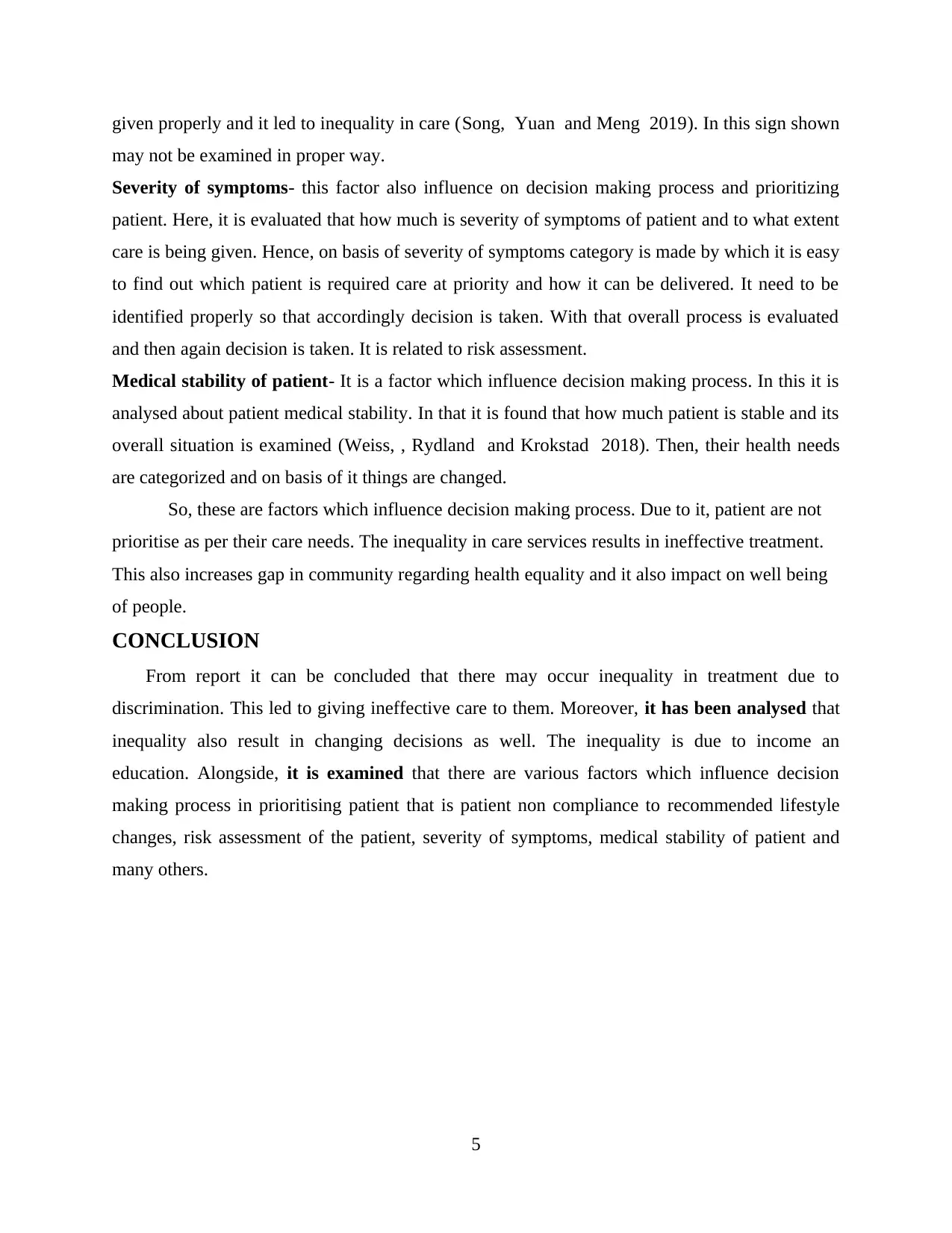
given properly and it led to inequality in care (Song, Yuan and Meng 2019). In this sign shown
may not be examined in proper way.
Severity of symptoms- this factor also influence on decision making process and prioritizing
patient. Here, it is evaluated that how much is severity of symptoms of patient and to what extent
care is being given. Hence, on basis of severity of symptoms category is made by which it is easy
to find out which patient is required care at priority and how it can be delivered. It need to be
identified properly so that accordingly decision is taken. With that overall process is evaluated
and then again decision is taken. It is related to risk assessment.
Medical stability of patient- It is a factor which influence decision making process. In this it is
analysed about patient medical stability. In that it is found that how much patient is stable and its
overall situation is examined (Weiss, , Rydland and Krokstad 2018). Then, their health needs
are categorized and on basis of it things are changed.
So, these are factors which influence decision making process. Due to it, patient are not
prioritise as per their care needs. The inequality in care services results in ineffective treatment.
This also increases gap in community regarding health equality and it also impact on well being
of people.
CONCLUSION
From report it can be concluded that there may occur inequality in treatment due to
discrimination. This led to giving ineffective care to them. Moreover, it has been analysed that
inequality also result in changing decisions as well. The inequality is due to income an
education. Alongside, it is examined that there are various factors which influence decision
making process in prioritising patient that is patient non compliance to recommended lifestyle
changes, risk assessment of the patient, severity of symptoms, medical stability of patient and
many others.
5
may not be examined in proper way.
Severity of symptoms- this factor also influence on decision making process and prioritizing
patient. Here, it is evaluated that how much is severity of symptoms of patient and to what extent
care is being given. Hence, on basis of severity of symptoms category is made by which it is easy
to find out which patient is required care at priority and how it can be delivered. It need to be
identified properly so that accordingly decision is taken. With that overall process is evaluated
and then again decision is taken. It is related to risk assessment.
Medical stability of patient- It is a factor which influence decision making process. In this it is
analysed about patient medical stability. In that it is found that how much patient is stable and its
overall situation is examined (Weiss, , Rydland and Krokstad 2018). Then, their health needs
are categorized and on basis of it things are changed.
So, these are factors which influence decision making process. Due to it, patient are not
prioritise as per their care needs. The inequality in care services results in ineffective treatment.
This also increases gap in community regarding health equality and it also impact on well being
of people.
CONCLUSION
From report it can be concluded that there may occur inequality in treatment due to
discrimination. This led to giving ineffective care to them. Moreover, it has been analysed that
inequality also result in changing decisions as well. The inequality is due to income an
education. Alongside, it is examined that there are various factors which influence decision
making process in prioritising patient that is patient non compliance to recommended lifestyle
changes, risk assessment of the patient, severity of symptoms, medical stability of patient and
many others.
5

6
⊘ This is a preview!⊘
Do you want full access?
Subscribe today to unlock all pages.

Trusted by 1+ million students worldwide
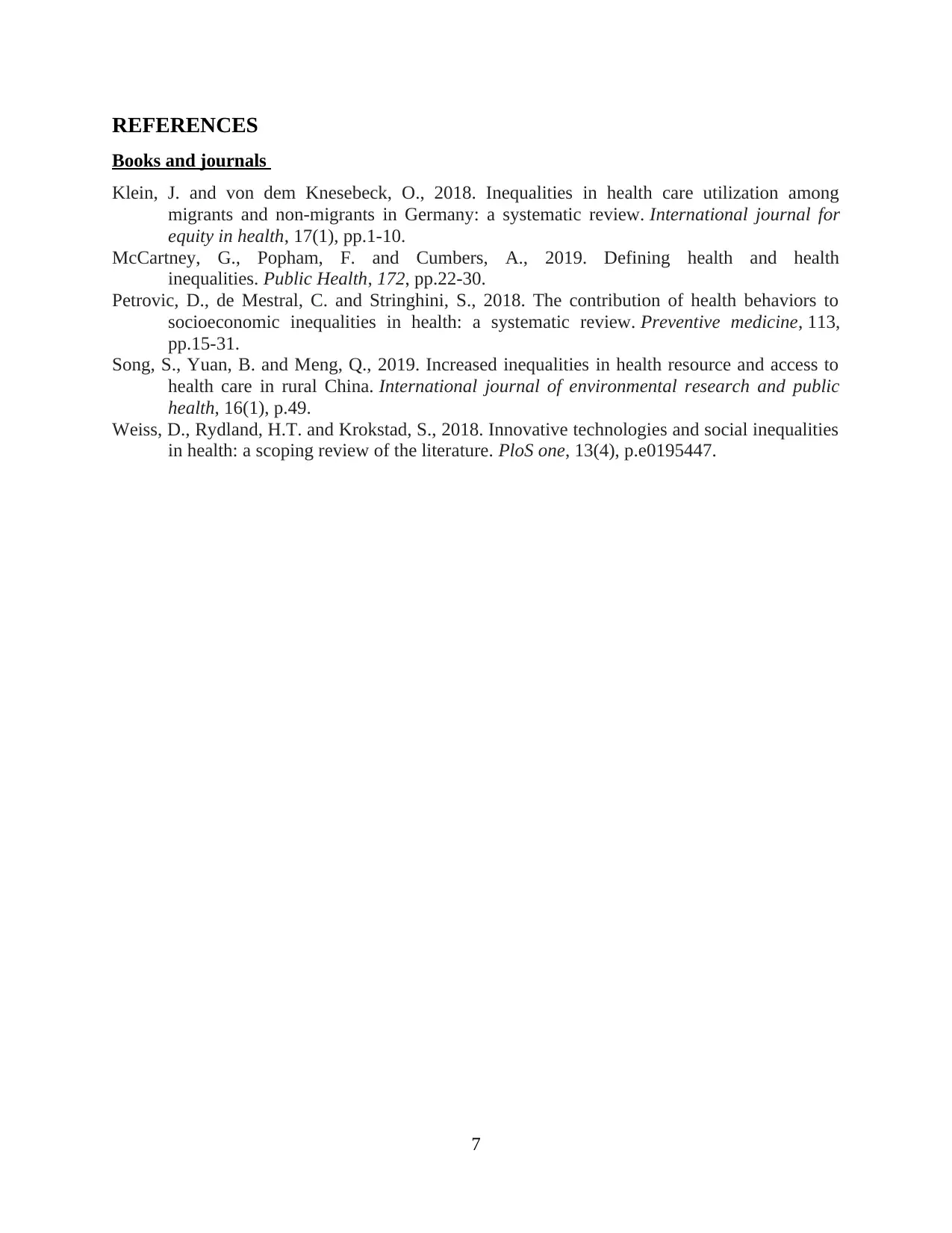
REFERENCES
Books and journals
Klein, J. and von dem Knesebeck, O., 2018. Inequalities in health care utilization among
migrants and non-migrants in Germany: a systematic review. International journal for
equity in health, 17(1), pp.1-10.
McCartney, G., Popham, F. and Cumbers, A., 2019. Defining health and health
inequalities. Public Health, 172, pp.22-30.
Petrovic, D., de Mestral, C. and Stringhini, S., 2018. The contribution of health behaviors to
socioeconomic inequalities in health: a systematic review. Preventive medicine, 113,
pp.15-31.
Song, S., Yuan, B. and Meng, Q., 2019. Increased inequalities in health resource and access to
health care in rural China. International journal of environmental research and public
health, 16(1), p.49.
Weiss, D., Rydland, H.T. and Krokstad, S., 2018. Innovative technologies and social inequalities
in health: a scoping review of the literature. PloS one, 13(4), p.e0195447.
7
Books and journals
Klein, J. and von dem Knesebeck, O., 2018. Inequalities in health care utilization among
migrants and non-migrants in Germany: a systematic review. International journal for
equity in health, 17(1), pp.1-10.
McCartney, G., Popham, F. and Cumbers, A., 2019. Defining health and health
inequalities. Public Health, 172, pp.22-30.
Petrovic, D., de Mestral, C. and Stringhini, S., 2018. The contribution of health behaviors to
socioeconomic inequalities in health: a systematic review. Preventive medicine, 113,
pp.15-31.
Song, S., Yuan, B. and Meng, Q., 2019. Increased inequalities in health resource and access to
health care in rural China. International journal of environmental research and public
health, 16(1), p.49.
Weiss, D., Rydland, H.T. and Krokstad, S., 2018. Innovative technologies and social inequalities
in health: a scoping review of the literature. PloS one, 13(4), p.e0195447.
7
1 out of 7
Related Documents
Your All-in-One AI-Powered Toolkit for Academic Success.
+13062052269
info@desklib.com
Available 24*7 on WhatsApp / Email
![[object Object]](/_next/static/media/star-bottom.7253800d.svg)
Unlock your academic potential
Copyright © 2020–2025 A2Z Services. All Rights Reserved. Developed and managed by ZUCOL.





